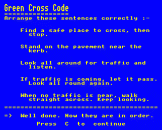Introduction
This pack contains two Sentence Sequencing programs on cassette ('Get it into Order' and 'Nursery Rhymes'). Loading instructions appear on the inside front cover of this pack. All other instructions are contained in the programs and are shown on the screen.
Each program presents a series of jumbled sentences which must be rearranged to form a nursery rhyme or a logical sequence of sentences. Sentences to be moved are first located and selected using the cursor up and cursor down keys. The sentences are then moved using the number 2 and 3 keys.
The "Teachers' Notes" give the user control over the length of time that a child works. Once the time is selected, up to 20 children can use the program and their results will be stored for later recall.
Contents
INDEX, ORDER, RHYMES
Loading Instructions
Select the number of the program you wish to load and press RETURN. Normal cassette operating messages are given during loading. Once the correct position on the cassette is reached each program takes two to three minutes to load.
Note: Programs can also be loaded and run in the usual way with the CHAIN command; to load and run the program ORDER, for example, type CHAIN "ORDER" and press RETURN.
Inserting New Sentences
Once your students have become familiar with the groups of phrases supplied on the Sentence Sequencing program you may like to replace them with your own teaching material. The procedure for replacing existing groups of phrases and then saving the amended program is given below.
- Select and load the program you wish to amend.
- Press BREAK.
- Type OLD and press RETURN.
- Hold down CTRL and press N (this turns page mode on for listing, although nothing appears on the screen).
- Type LIST 6000, and press RETURN.
The section of the program that contains DATA statements will be displayed in a list on the screen. Each statement begins with a line number and is part of an ordered set of sentences. The final DATA statement in each set will be XXX.
If the DATA statements that you wish to change are not on the screen, press SHIFT to move on to the next page.
- Press ESCAPE to end the listing of the program.
- Move the cursor using the arrow keys to the beginning of the appropriate data statement.
- Press COPY to copy the data statement up to the position where the new sentence is to be inserted. This should be after the double quote which follows the word DATA.
- Ensure that the caps lock light is off.
- Type in your new sentence, putting a double quote after it.
- Press RETURN.
Any of the program lines containing DATA statements can be replaced by typing them out again or using this method of copying. Whenever a new program line is typed it replaces the old version of that program line. A data statement can be removed by typing its line number and then pressing RETURN. Sets consist of up to six sentences followed by the DATA XXX statement. A new program line can be inserted between two other lines by giving it a line number that is larger than one and smaller than the other.
- Press SHIFT and CAPS LK to turn the caps lock light on.
- Type RUN and press RETURN.
- When the changes have been tested, press BREAK to leave the program.
- Type OLD and press RETURN.
- Save this version on to cassette by typing SAVE "filename" and press RETURN.
NOTE: We recommend that you can use your own filename so that the original program remains intact. In this case, your new version of the program cannot be loaded via the INDEX, but you should use the CHAIN or LOAD command, for example: CHAIN "filename" (RETURN)







